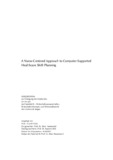Citation link:
http://dx.doi.org/10.25819/ubsi/10355| DC Field | Value | Language |
|---|---|---|
| dc.contributor.author | Uhde, Alarith | - |
| dc.date.accessioned | 2023-08-16T08:25:12Z | - |
| dc.date.available | 2023-08-16T08:25:12Z | - |
| dc.date.issued | 2023 | de |
| dc.description.abstract | Nurse shift planning is a central work organization process in hospitals and other healthcare institutions. The shift plan provides a frame for all further healthcare activities by regulating staffing levels and group compositions at all times and on each day of the week. In addition, it fundamentally shapes each individual nurse’s life, often disturbs their circadian rhythms, and limits their ability to organize social activities. As a result, shift planning often brings challenges for nurses' physical and psychological health, and it can reduce their subjective well-being. There is a long history of research on how to improve the shift planning process, with two contrasting approaches. The first approach focuses on efficiency and full automation of the shift planning process. Its central motivation is that more efficient shift planning may free time and resources that can be used for other healthcare tasks, and that it helps to optimize staffing levels to meet the demand. A downside is that it excludes nurses from the planning process and reduces direct control of their shift plans, which creates work-life conflicts that negatively affect their well-being. The second approach gives full control of the shift plan to the nurses. This allows them to better integrate their work and private lives, but it can be inefficient and substantially increase workload for nurses, particularly in larger groups. This thesis presents the design and evaluation of an approach to shift planning that attempts to combine the best of both worlds, but with a focus on the nurses' perspective. The research followed a nurse-centered design process, focusing specifically on subjective fairness and subjective well-being from the perspective of the nurses affected by shift planning. In addition, automatic processes were included if they did not interfere with the primary goal to create a shift planning system that promotes nurses' fairness and well-being. The empirical section covers five studies. In Studies 1 and 2, we investigated nurses' subjective fairness experiences in the context of shift planning. Nurses understood fairness as equality (“everyone is treated equally”) for the general distribution of resources, such as free weekends. But in concrete planning decisions about free shifts, they understood fairness based on individual needs (“the person with a greater need gets the day off”), which has fundamental implications for how fair conflict resolution should be designed. In addition, nurses experienced involvement in the decision-making process as a central facet of fairness (i.e., procedural fairness). Study 3 covers the conceptual design of a nurse-centered shift planning system with the goal to promote subjective fairness and subjective well-being, based on interview studies with nurses and healthcare planners. Study 4 describes a nine-month appropriation study of a prototypical shift planning system that followed this conceptual design, in a ward of a retirement community. We found that some nurses used the system regularly for planning, but others did not. These differences were partially based on different lifestyles (e.g., planning months ahead vs. not planning the next week) and social considerations (e.g., preserving the reputation as a reliable and hard-working colleague). We also identified informal conflict negotiation practices (e.g., rescheduling private events, sharing shifts), informal functions of leadership (e.g., “pushing” colleagues to take time for themselves), and implications of the shift plan's release date on nurses' ability to plan for their private lives. Finally, in Study 5 we compared the informal conflict negotiation practices identified in Study 4 with an alternative, fully automated conflict resolution process. The interactive version had positive effects on fairness, well-being, and team spirit. | en |
| dc.identifier.doi | http://dx.doi.org/10.25819/ubsi/10355 | - |
| dc.identifier.uri | https://dspace.ub.uni-siegen.de/handle/ubsi/2557 | - |
| dc.identifier.urn | urn:nbn:de:hbz:467-25570 | - |
| dc.language.iso | en | de |
| dc.rights | Attribution-NonCommercial-NoDerivatives 4.0 International | * |
| dc.rights.uri | http://creativecommons.org/licenses/by-nc-nd/4.0/ | * |
| dc.subject.ddc | 330 Wirtschaft | de |
| dc.subject.other | Schichtplanung | de |
| dc.subject.other | Shift Plannung | en |
| dc.subject.other | Nurse Scheduling Problem | en |
| dc.subject.other | Fairness | en |
| dc.subject.other | Subjective Well-being | en |
| dc.subject.other | Problem der Schichtplanung bei Krankenschwestern | de |
| dc.subject.other | Fairness | de |
| dc.subject.other | Subjektives Wohlfühlen | - |
| dc.subject.swb | Arbeitszeit | de |
| dc.subject.swb | Arbeitsplanung | de |
| dc.subject.swb | Fairness | de |
| dc.title | A nurse-centered approach to computer-supported healthcare shift planning | en |
| dc.title.alternative | Ein pflegekräftezentrierter Ansatz der Computer-gestützten Schichtplanung im Gesundheitswesen | de |
| dc.type | Doctoral Thesis | de |
| item.fulltext | With Fulltext | - |
| ubsi.contributor.referee | Hassenzahl, Marc | - |
| ubsi.date.accepted | 2023-08-14 | - |
| ubsi.organisation.granting | Universität Siegen | - |
| ubsi.origin.dspace5 | 1 | - |
| ubsi.publication.affiliation | Fakultät III - Wirtschaftswissenschaften, Wirtschaftsinformatik und Wirtschaftsrecht | de |
| ubsi.subject.ghbs | QGTO | de |
| Appears in Collections: | Hochschulschriften | |
Files in This Item:
| File | Description | Size | Format | |
|---|---|---|---|---|
| Dissertation_Uhde_Alarith.pdf | 2.88 MB | Adobe PDF |  View/Open |
This item is protected by original copyright |
Page view(s)
774
checked on Nov 29, 2024
Download(s)
456
checked on Nov 29, 2024
Google ScholarTM
Check
Altmetric
This item is licensed under a Creative Commons License


